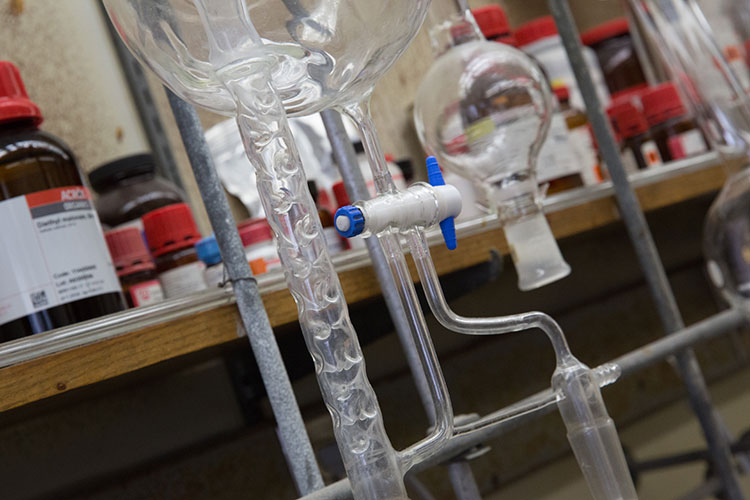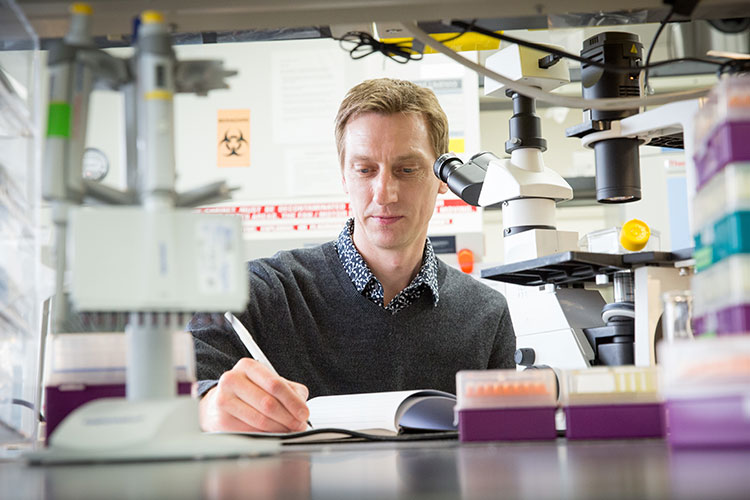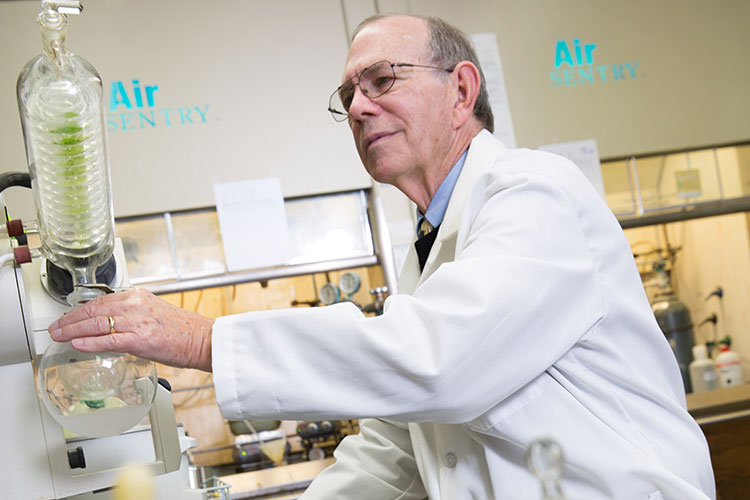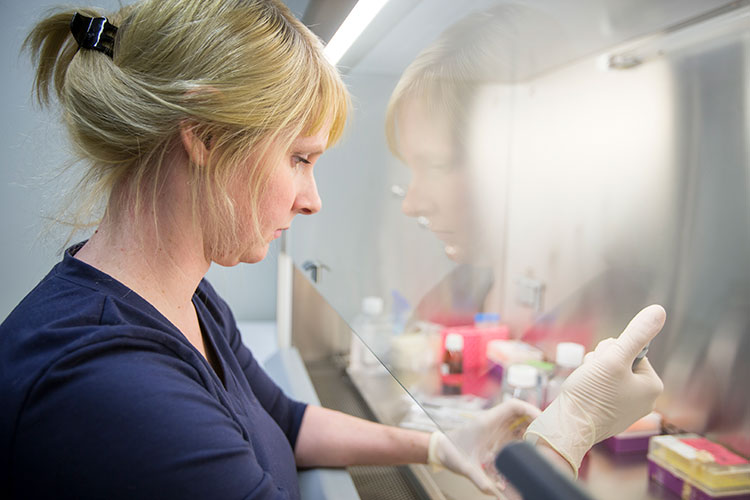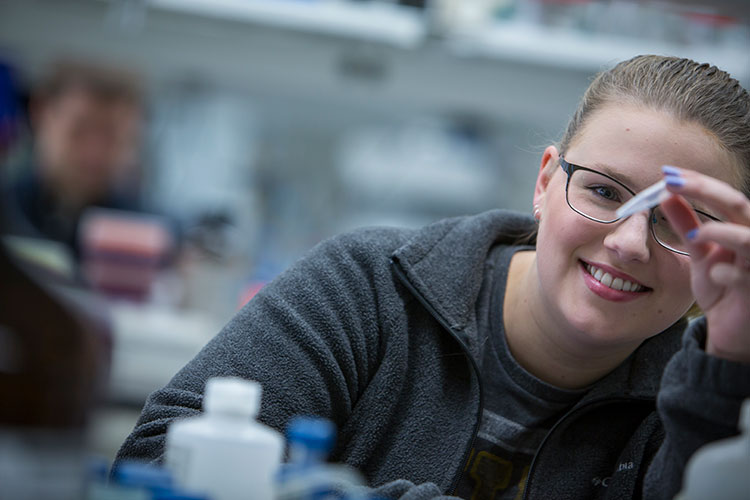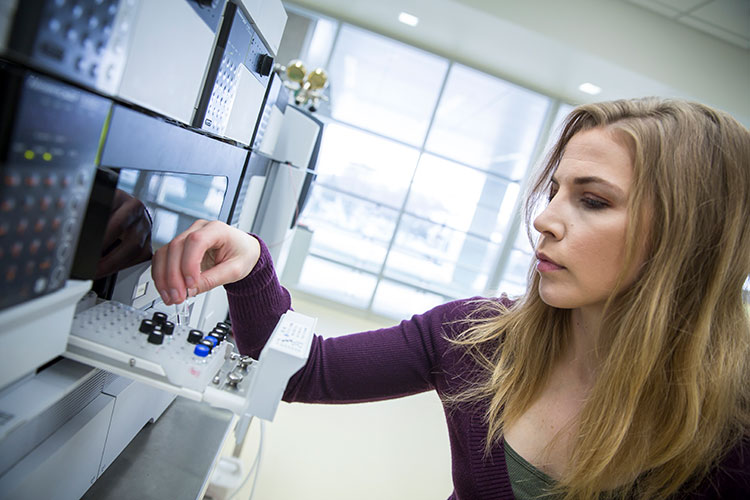
The Chemistry of Cure
The Milwaukee Institute for Drug Discovery combines research talent with the tools needed to create the next generation of treatments.
The most common treatments for asthma, which is the most prevalent chronic childhood disease, require an inhaler. But a big problem with inhalers, used to deliver steroids and other drugs in an aerosol form, is that children often don’t operate them properly. Parents also worry about side effects from their children’s long-term use of steroids.
Now, a team of scientists, including three from UWM, is poised to dramatically change how physicians treat asthma. They’re developing a drug that would replace steroids as the therapeutic agent, reducing side effects and making treatment as simple as swallowing a pill.
“We would revolutionize the field if we could replace the inhaler,” says Douglas Stafford, director of UWM’s Milwaukee Institute for Drug Discovery, or MIDD. “These are critical design factors that are just as important as drug efficacy.”
Fueled by a $2 million grant from the National Institutes of Health, the team of researchers is trying to make the inhaler obsolete. They’re redesigning a drug compound first created by UWM’s James Cook to calm anxiety without dangerous side effects.
A paper published April 25 in the journal Molecular Pharmaceutics describes how the researchers have already cleared major hurdles.
Launched in 2011, the MIDD’s dual goals are to advance basic science and develop new pharmaceuticals. The institute encompasses the labs of a dozen UWM faculty members as well as the Shimadzu Laboratory for Advanced and Applied Analytical Chemistry.
Among the Shimadzu lab’s impressive suite of instruments are six state-of-the-art mass spectrometers. The workhorses of new drug development, these machines allow researchers to identify individual compounds and track their distribution in a biological sample.
Cook, distinguished professor of chemistry, is one of UWM’s most prolific inventors. Specializing in natural products, he holds 47 patents or patent applications for drug compounds. More than half are through the UWM Research Foundation, and his body of work is a cornerstone of MIDD research.
The asthma project redirects Cook’s central nervous system-oriented work to an entirely different part of the body. “That’s the value of the MIDD,” Stafford says. “It brings together interdisciplinary teams with an eye toward products that can improve people’s lives.”
More than a dozen collaborators from other institutions are teaming with UWM faculty on drug discovery initiatives aimed at cancer, chronic pain and much more. At least a dozen other groups, including companies such as PhysioGenix and Eurofins, have come to the MIDD for analytical chemistry support on their own projects.
That’s how the asthma project began – with a simple email. Dr. Charles Emala, a Columbia University Medical Center anesthesiologist, wanted to use Cook’s compounds in some research on lung physiology. The experiments weren’t originally intended for finding an asthma treatment, but his findings led down that path.
Over the years, Cook had created a vast library of compounds that tame anxiety, and do so without the threat of sedation or dependence that comes from drugs like Valium and Xanax. The compounds act on a neurotransmitter – a substance that regulates communication among brain cells.
There are dozens of neurotransmitters, and the one that many of Cook’s compounds targeted – called gamma-aminobutyric acid, or GABA – suppresses brain activity. Taking advantage of this effect, sedatives and anti-seizure drugs do their jobs by enhancing GABA through one or more of its receptors.
Emala had discovered that GABA receptors exist in the lungs. Was it possible to harness those receptors to relax the smooth muscles in the airways of the lungs?
The idea made sense to Stafford. As an immunologist, he’s well-acquainted with the problems of inflammation, a runaway immune response that underlies a host of maladies from asthma to arthritis.
Cook’s GABA-based compound library immediately came to mind.
“Emala’s email was like a Christmas present,” Cook says. “In 2008, our lab had made compounds that might work for this purpose. But lacking biology, they were just put on a shelf.”
The asthma project is halfway into a four-year grant, and the researchers have confirmed that their compounds reduce airway inflammation, while limiting blood-brain barrier exposure. This means the compounds can target GABAA receptors in the lung responsible for asthma symptoms without affecting similar receptors in the brain.
Meanwhile, the UWM Research Foundation has filed three patents on the work so far. It’s just one example of the MIDD’s ambitions and potential.
In the lab
The Shimadzu lab, opened in 2014, has put UWM in the drug development game, Stafford says. Under the direction of Shama Mirza, who’s also an assistant professor of biochemistry, the lab gives researchers tools to advance further in the testing process, answer new questions and work with companies that could eventually bring new drugs to market.
Creating and redesigning chemical compounds is a job tailor-made for mass spectrometry. It allows scientists to dismantle molecules and learn their structure by examining their mass and charge.
The applications are far-ranging, from identifying trace amounts of a contaminant in the environment to revealing the elements contained on planetary surfaces.
In drug discovery, a promising compound must have both a biological target – a protein or cellular process that’s involved in the disease – and a molecule engineered to interact with the target in a certain way. Deciding upon the latter often involves sifting through libraries of premade molecules to see which keys will fit a specific lock.
Mass spectrometry is essential to finding both lock and key. It also reveals where a compound ultimately goes once it enters the body, how fast it is metabolized and is cleared from the body, what amount achieves the desired effect, and how a compound changes when it breaks down in the body.
The further you can go in the process and the more promising it is, Stafford says, the more likely a pharmaceutical company is to license it.
In addition to finding medications that help people, the basic science done while searching for new drugs has an oft-overlooked result: a better understanding of how the body works.
“We want to come up with a drug, but we also want to understand the disease we are studying,” says Alexander “Leggy” Arnold, UWM associate professor of chemistry. “With the help of mass spectrometry, we are making these small molecules that can probe these biological questions. We can find out what is happening in the body.”
For university researchers, it’s relatively rare to have intellectual property licensed by a company. Getting a product all the way to the marketplace is an even longer shot.
Taking a potential drug from the lab bench to the customer usually requires 10 to 15 years and more than a billion dollars of investment. The failure rate along that path is high, with only about 5 percent of candidates reaching your neighborhood pharmacy.
To manage risk, drug companies are relying more and more on academic researchers to conduct the early stages of drug discovery. UWM is a member of the Academic Drug Discovery Consortium, an organization launched in 2012 that coordinates activities among 115 such centers in the United States and nine other countries.
And the MIDD’s work has already resulted in a license. It’s for a compound produced by Arnold to treat ovarian cancer, a lethal disease that often becomes resistant to chemotherapy drugs. Medical consulting group Systems Oncology has an exclusive agreement with the UWM Research Foundation, which manages the patent on Arnold’s work, to pursue commercializing the compound.
New ways to fight cancer
Arnold has always been fascinated by products the body makes – like calcium and vitamin D – as therapeutic targets. Although they’re known for their roles in bone health, vitamin D and calcium do much more.
Arnold has created compounds that harness the “master regulator” of calcium in the body – the vitamin D receptor, or VDR. Activated by metabolic products of vitamin D, the VDR gives instructions to genes for proper cell growth and differentiation, making it a target for slowing the growth of cancer cells.
“Many women know the drug tamoxifen as a savior in the fight against breast cancer,” Arnold says. “That drug’s action is mediated by the estrogen receptor, a close relative of VDR. Initial studies suggest that new drug candidates that bind the VDR can help to fight other cancers.”
In fact, several new anti-cancer drugs in clinical trials are based on vitamin D, but a downside is they might disrupt vital calcium levels over time. Arnold’s compounds alter the VDR’s action selectively, so the drugs can work and not interfere with the calcium regulation needed for normal health.
Another MIDD cancer drug project began with the goal of giving physicians a tool to help decide the best treatment for an aggressive brain cancer. Now the research has produced a drug candidate that is nearly ready for human trials.
Glioblastoma is a death sentence. There is no cure, and less than 10 percent of people diagnosed with it will live for five years. Of those who die before five years, many develop a resistance to the treatment, and their tumors reappear more aggressively than before.
Shama Mirza came to UWM in 2016, but she first encountered the disease while working at the Medical College of Wisconsin. There, she was on a team that supported oncologists as they treated patients. She learned that glioblastoma patients fall into two categories: those who develop a resistance to chemotherapy or radiation therapy and don’t survive very long, and those who are not resistant and live longer.
“Knowing who would benefit from the therapies and who would not – that is the guessing game we are playing now,” Mirza says.
She and her colleagues began looking for a biomarker, a protein that would predict the survival category of glioblastoma patients. “Proteins are the ultimate drug targets because they are responsible for so many life processes,” Mirza says.
The protein they ultimately found is also involved in the cancer’s growth. That presented a chance to seek a better treatment option – a drug that would block the protein, something current treatment does not do effectively.
Mirza and a colleague hit pay dirt by finding an existing compound that inhibits the targeted protein. The compound is already used in other countries to treat a different kind of cancer.
“If the results of human trials agree with our current findings,” Mirza says, “it’s going to be huge for these patients.”
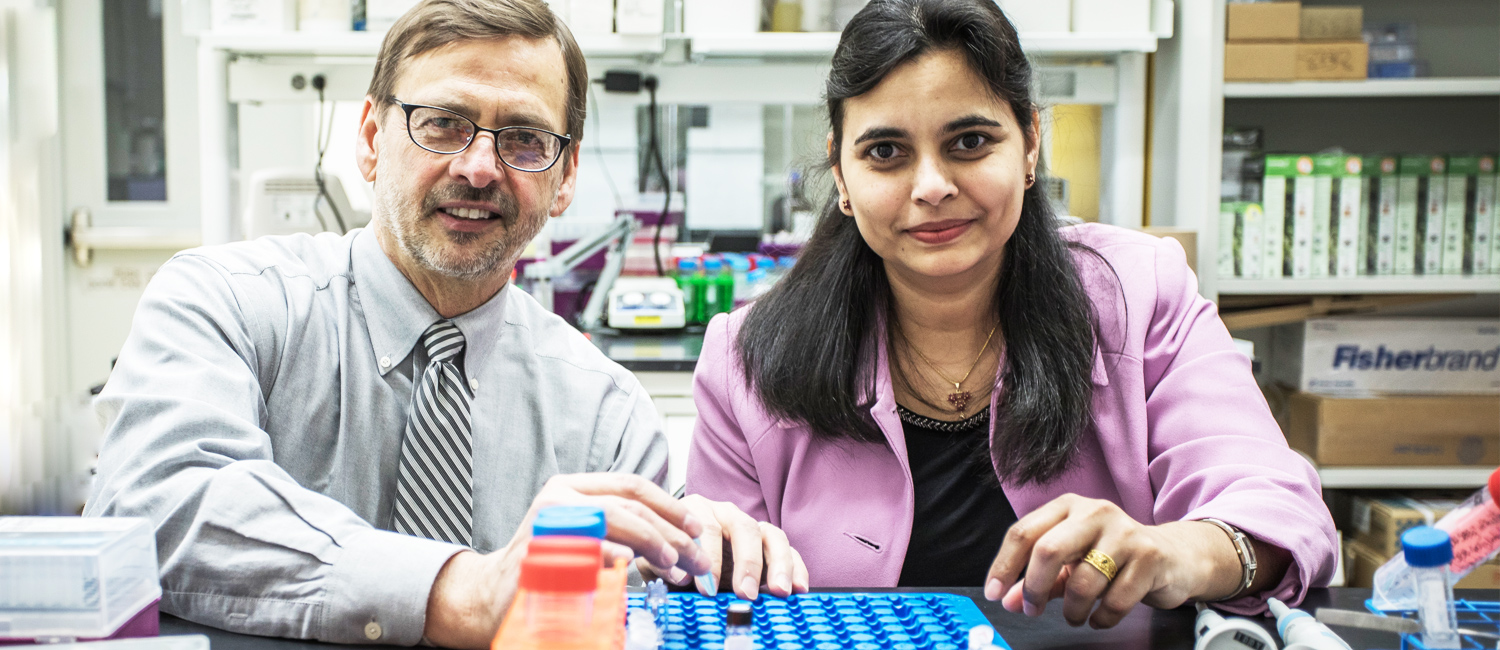
The pain paradox
The annual cost of chronic pain in the U.S. is estimated at $100 billion, which accounts for health care expenses, and lost income and productivity.
At the same time, the U.S. is experiencing an opioid abuse epidemic. More Americans died of a drug overdose in 2015 than any other year on record – and more than half of those deaths involved opioids, according to the Centers for Disease Control and Prevention.
So, is it possible to pharmaceutically manage real pain while also curbing the abuse of opioids? Supported by the NIH, Cook and Arnold are seeking an answer. They’re developing a non-opiate medication for pain by pursuing the same approach used in the asthma pill project.
Pain drugs like oxycodone, hydrocodone and morphine work by targeting opioid receptors, increasing the flow of the neurotransmitter dopamine, which stimulates the brain’s pleasure center. But with long-term abuse, opioid receptors compensate by limiting dopamine, so users must take more of the drug to maintain the same level of “high.”
Cook and Arnold are seeking a drug that manages pain as effectively as opioids, but without the risk of addiction. They are targeting the GABA receptors instead of opioid receptors, thereby replacing dopamine as the therapeutic agent and using GABA’s capacity to calm the sensation of pain.
Opioids and benzodiazepines like Xanax cause addiction in similar ways. And Cook had originally designed his anti-anxiety compounds to selectively target GABA receptors, thus getting around the problem of sedation and dependence in benzodiazepines.
In 2006, pharmaceutical giant Bristol-Myers Squibb licensed a family of Cook’s anti-anxiety compounds with the intention of putting a new medication on the market. In human trials, however, the company learned that the compounds didn’t remain in the body long enough, so the project was dropped.
Today, Cook’s lab has modified the chemical structure to improve its half-life, and the compounds are again available for licensing through the UWM Research Foundation.
As UWM’s non-opioid drug project progresses, researchers may encounter different side effects associated with GABA agents, Cook says – the loss of muscle coordination, for instance. Or they may just develop a new generation of pain medication with no side effects at all.
Time and testing will tell.
